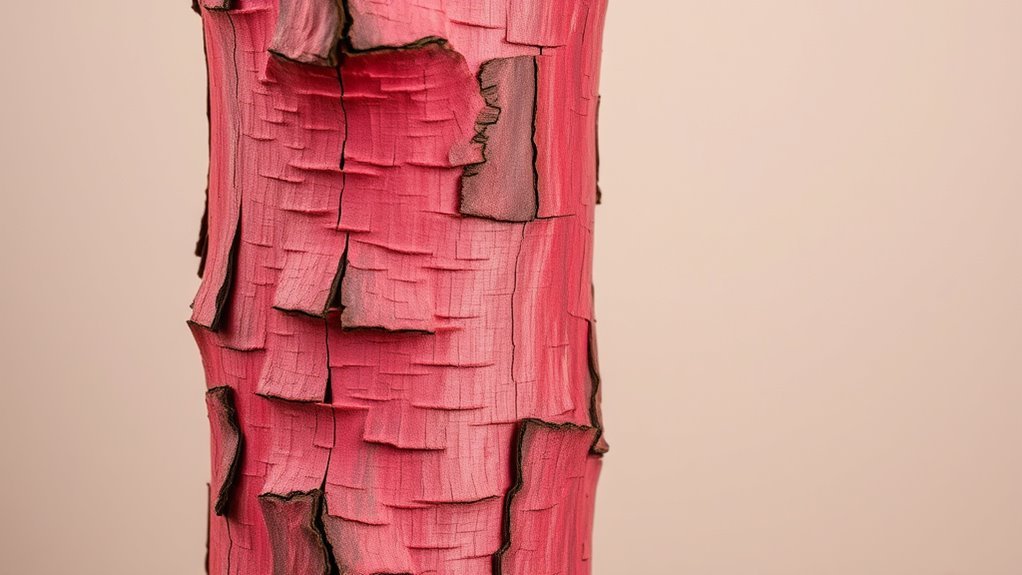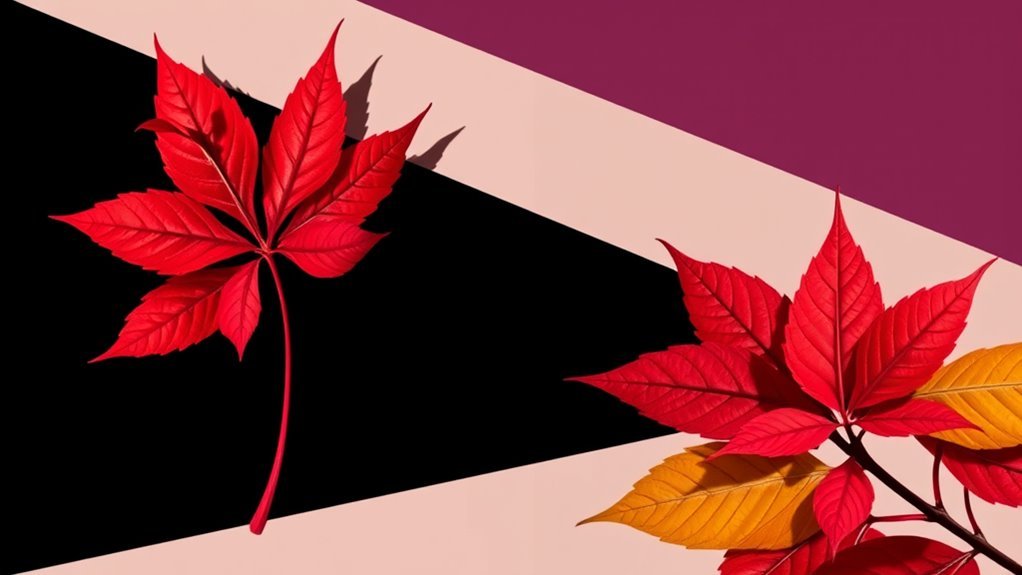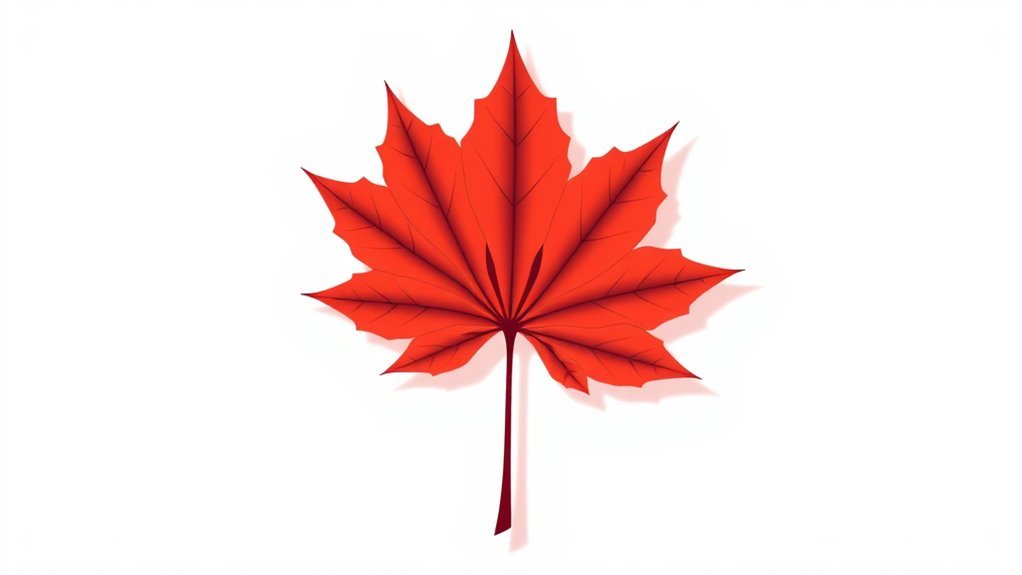Japanese Maple and Eastern Redbud trees each exhibit unique bark characteristics that improve their beauty. Japanese Maple bark ranges from vibrant green or reddish-brown in young trees to grayish-brown in older specimens, with a peeling texture. In contrast, Eastern Redbud features smooth, reddish-brown bark that develops shallow furrows over time. Both trees offer ornamental value, but their growth habits and environmental preferences differ, making the choice of tree dependent on specific surroundings needs. Further exploration reveals more intriguing details.
Main Points
- Japanese Maple bark varies in texture and color, transitioning from vibrant green or reddish-brown to grayish-brown with age.
- Eastern Redbud bark is smooth and thin with a reddish-brown exterior, developing shallow furrows as it matures.
- Both tree species offer distinct ornamental value, with Japanese Maple showcasing seasonal bark changes and Eastern Redbud enhancing visual appeal with spring blossoms.
- Japanese Maples prefer partial shade and well-drained soils, while Eastern Redbuds thrive in full sun and tolerate drought conditions once established.
- The bark of Japanese Maples is generally more textured, whereas Eastern Redbud bark is relatively delicate and smooth.
Overview of Japanese Maple Trees
Japanese maple trees, known for their stunning foliage and graceful form, are a popular choice among gardeners and terrain designers. These deciduous trees, primarily native to Japan, Korea, and China, showcase a wide variety of leaf shapes and colors, ranging from deep reds to vibrant greens and even purples.
Typically, they reach heights of 15 to 25 feet, making them suitable for both small gardens and larger environments.
Japanese maples thrive in well-drained soil and prefer partial shade, although some varieties can tolerate full sun. Their delicate branches and complex leaf patterns add visual interest throughout the seasons, especially in autumn when the leaves turn brilliant shades of crimson and gold.
Additionally, their compact size and elegant structure make them ideal for use as focal points in gardens or as part of mixed plantings.
In the end, the Japanese maple continues to be cherished for its aesthetic appeal and versatility in garden design.
Characteristics of Japanese Maple Bark

The bark of the Japanese maple is known for its unique texture and rich color, which can vary considerably among different cultivars.
Over the seasons, the bark undergoes noticeable changes, enhancing its visual appeal.
Understanding these characteristics is essential for appreciating the comprehensive beauty of the tree.
Texture and Color
Bark characteristics of the Japanese Maple are notable for their unique texture and color. The bark typically presents a smooth and thin surface, which can vary in hue depending on the specific cultivar.
Young trees often exhibit a vibrant green or reddish-brown bark, while older specimens develop a more mature, grayish-brown appearance with a tendency to peel in thin strips. This peeling reveals an inner layer that can be a brighter or richer shade, adding visual interest.
The texture is not only aesthetically pleasing but also contributes to the tree's overall appeal, making it a favorite among gardeners and horticulturists.
This distinct coloration and texture help the Japanese Maple stand out in various environments, enhancing its ornamental value.
Seasonal Changes
As seasons change, the bark of the Japanese Maple undergoes subtle transformations that reflect the tree's adjustment to its environment.
In spring, the bark remains relatively smooth and vibrant, often showcasing a rich reddish-brown hue. As summer progresses, the bark darkens, developing a more textured appearance as the tree matures.
By autumn, the bark may display subtle variations in color, influenced by the changing foliage surrounding it, but the essence of its beauty remains intact.
In winter, the bark becomes more pronounced, with its elaborate patterns highlighted against the stark backdrop of a barren terrain.
These seasonal changes not only improve the aesthetic appeal of the Japanese Maple but also signify its resilience and flexibility throughout the year.
Overview of Eastern Redbud Trees
Eastern redbud trees, known for their stunning spring blossoms, are a popular choice among terrain designers and homeowners alike. These deciduous trees are native to North America and are cherished for their vibrant aesthetic and versatility.
- Blossoms: In early spring, the branches burst into a profusion of small, pink to purple flowers that attract pollinators, creating a breathtaking visual display.
- Foliage: As the seasons progress, heart-shaped leaves unfurl, showcasing a rich green that turns golden-yellow in the fall, enhancing the scenery's color palette.
- Form: Eastern redbuds typically grow to 20-30 feet tall and 25-35 feet wide, making them ideal for small gardens or as focal points in larger environments.
This enchanting tree not only adds beauty but also provides essential habitat for local wildlife, solidifying its status as a beloved choice in diverse settings.
Characteristics of Eastern Redbud Bark

The texture and appearance of the Eastern redbud's bark contribute greatly to its general charm. Defined by a smooth, thin, and reddish-brown exterior, the bark displays a striking visual appeal. As the tree matures, the bark undergoes changes, developing shallow furrows and a more textured surface that adds depth to its aesthetic. The bark's color can vary slightly, showcasing hues from light brown to a deeper, almost purplish tint, enhancing its ornamental value.
Additionally, the Eastern redbud's bark is relatively delicate compared to that of other tree species, making it susceptible to damage from environmental factors. This fragility, nonetheless, does not detract from its beauty; rather, it highlights the tree's elegance.
The bark, alongside its stunning spring blossoms, forms an important aspect of the Eastern redbud's overall visual presence, making it a popular choice for gardens and parks.
Comparison of Foliage Color and Texture

A striking contrast exists between the foliage of Japanese maple and Eastern redbud, each offering unique visual characteristics. The Japanese maple, known for its delicate, finely dissected leaves, showcases a vibrant palette ranging from deep red to bright green.
In contrast, the Eastern redbud presents broad, heart-shaped leaves that emerge in a lush green, shifting to golden hues in autumn.
To further illustrate their distinctions, consider:
- Japanese Maple: Leaves that can display complex patterns and colors, creating a stunning visual display in gardens.
- Eastern Redbud: Leaves with a smooth texture and heart-like shape, providing a softer, more rounded appearance.
- Seasonal Variation: The Japanese maple often maintains vibrant colors throughout spring and summer, while Eastern redbud offers delightful pink blooms that precede its foliage.
Together, these trees improve any setting with their unique foliage attributes.
Growth Habits and Requirements
While both Japanese maple and Eastern redbud thrive in similar environments, their growth habits and requirements differ considerably.
Japanese maples are typically slower-growing, reaching heights of 10 to 25 feet, depending on the variety. They prefer well-drained, slightly acidic soils and thrive in partial shade to full sun. Their delicate branches require protection from strong winds.
In contrast, Eastern redbuds grow more rapidly, often reaching heights of 20 to 30 feet. They are versatile to a range of soil types, favoring well-drained, moist conditions.
Eastern redbuds prefer full sun to partial shade and are more tolerant of drought once established.
Choosing the Right Tree for Your Landscape
Selecting the right tree for a setting involves careful consideration of various factors, including growth habits and environmental preferences.
Japanese maples, redbuds, and eastern redbuds each offer unique characteristics that can improve a scenery.
When choosing among these options, one should consider:
- Size and Shape: Japanese maples typically exhibit a graceful, compact form, while redbuds boast a broad, spreading canopy.
- Seasonal Appeal: Japanese maples are known for their stunning fall color, whereas redbuds display vibrant pink flowers in spring.
- Soil and Sunlight Needs: Japanese maples prefer partial shade and well-drained soil, while redbuds thrive in full sun and versatile soils.
Common Questions
What Are the Best Soil Types for Japanese Maples?
The best soil types for Japanese maples typically include well-drained, loamy soils enriched with organic matter. Slightly acidic to neutral pH levels are preferred, ensuring ideal growth and vibrant foliage for these ornamental trees.
How Fast Do Eastern Redbuds Grow?
The growth rate of Eastern Redbuds typically ranges from 1 to 2 feet per year. Their rapid establishment and flexibility to various soil types make them a popular choice for landscaping and urban settings.
Can Japanese Maples Tolerate Full Sun?
The question of full sun tolerance is important for many tree species. Japanese maples generally prefer partial shade, as excessive sun exposure can lead to leaf scorch and stress, impacting their overall health and aesthetic appeal.
What Pests Commonly Affect Redbud Trees?
Redbud trees commonly face pests such as leafhoppers, caterpillars, and scale insects. These pests can cause damage by feeding on leaves or stems, leading to reduced vigor and general health of the tree if not managed.
How Do I Propagate Japanese Maple Trees?
To propagate Japanese maple trees, one can use softwood cuttings taken in early summer, ensuring proper moisture and humidity. Alternatively, seeds can be collected and stratified for successful germination, promoting healthy growth in new plants.

